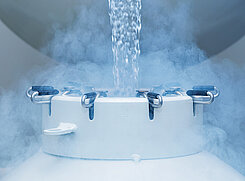Mass Flow Rate Calculator
Do you know the volumetric flow of a gas or gas mixture, but need to express it as mass flow? The KNF Mass Flow Rate Calculator makes it easy. Simply select your gas or gas mixture, enter the volumetric flow rate and our calculator will give you the result. If the gas in your application is at a different temperature or pressure than the one preset in the calculator, you will be able to adjust that as well.
Enter your preferred data to calculate your mass flow
²Density is calculated dynamically based on gas, pressure and temperature.
³*All density values are given in accordance with ISO 8778 at 20 °C (293,15 °K, 68 °F) and 1 bar absolute (14,5 psi, 750,06 torr).
How to Use the KNF Mass Flow Rate Calculator
Volumetric flow is the most common way to represent flow. However, some applications, such as chemical processes, require the actual amount of gas molecules. In these applications, it is much more useful to express the flow as mass flow. For this reason, KNF has developed this mass flow rate calculator, which makes it easy to convert from volumetric flow rate to mass flow rate. Simply enter the gas or gas mixture to be transferred and its volumetric flow rate. If you know the exact density of your media, you can enter it directly into the KNF Mass Flow Rate Calculator instead of selecting a gas or gas mixture. Then, please also enter the temperature and pressure of the gas in your application.

Mass Flow Rate Calculator FAQ
Each gas has a specific gas constant. The specific gas constant, temperature and pressure can be used to calculate the density of the gas. Therefore, knowing the specific gas constant of the gas is critical to converting from volumetric flow rate to mass flow rate.
This option is intended for gases or gas mixtures with a known specific gas constant and is not listed in our drop-down menu. If the specific gas constant of a gas or a gas mixture is known, entering it into the KNF Mass Flow Rate Calculator is an alternative option to specifying all the components of the mixture.
Temperature and pressure can be freely adjusted to the conditions of the application using the KNF Mass Flow Calculator. The preset values are given in accordance with ISO 8778. These parameters are also used for all gas flow rates given in KNF data sheets.
The temperature and the pressure of a gas have a significant impact on its mass and therefore the mass flow. The same volumetric flow rate will result in a higher mass flow rate at lower temperatures and or higher the pressures and vice versa.




